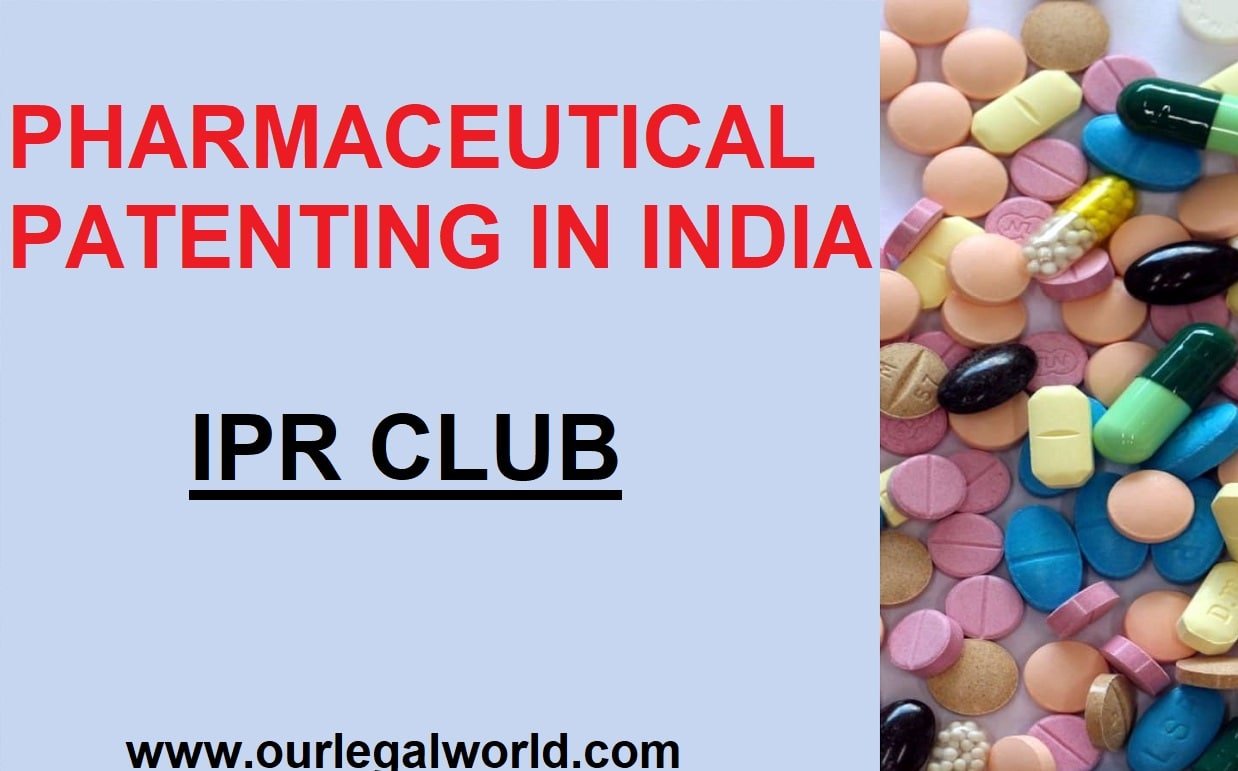PHARMACEUTICAL PATENTING IN INDIA: IPR CLUB OURLEGALWORLD
INTRODUCTION
Intellectual property rights arose from commercial values, creativity and invention. Patents are a sort of intellectual property that refers to the rights granted to a person for the invention of a commercially valuable product or technique. A patent is not a new concept. Throughout history, there have been numerous inventions; in fact, inventions are one of the most valuable intellectual property assets for the owner because they grant them the exclusive right to exclude others from using, selling, and distributing those inventions once they obtain patent protection for it, which lasts at least 20 years from the date the patent application was filed.
Pharmaceutical patents are often seen as a strategy used by corporations to deny ordinary people access to life-saving drugs and public health. Unlike popular belief, pharmaceutical corporations use innovation and clever procedures to facilitate and secure investment for R&D. An estimated amount of almost 80% of overall earnings for pharmaceutical businesses come from unique tactics covered by patents. True, there are significant costs connected with developing and bringing a novel drug to market, but successful drugs frequently offer a far better return on investment.[i] Pharmaceutical businesses face a clash between the right to health and the right to patent.
The right to health is a crucial and essential right guaranteed and enshrined under Article 21 of the Constitution of India, and in the current situation, not much justice is being done to it, as lifesaving drugs are granted monopoly as a result, making them inaccessible to the general public due to exorbitant prices. The fact that these drugs are not affordable is always a major impediment to their accessibility, which is interpreted as a denial of access to public health. Because of the significant expenditures connected with medication research and development, it is an ethical quandary whether the rights and interests of the public or the private sector should be preserved.[ii] Thus, a patent system that preserves an equal balance of public and private interests is a preferable solution to address the issue that is evident in the Indian Patent System.
Pharmaceutical patents, which were designed and are still in use today, are intended to protect firms’ financial investments and recuperate costs involved with the discovery, creation, and advertising of new pharmaceuticals. Increasing patent exclusivity lowers the risk of the lengthy development process, encouraging businesses to pursue research and develop innovative therapies.
PHARMACEUTICAL SECTOR AND PATENTING IN INDIA
Given that Indian pharmaceutical companies are the main providers of low-cost active pharmaceutical components as well as finished products for domestic and developing-country use, pharmaceutical patenting is extremely important in terms of public health. Patenting products could destroy these industries, boosting drug prices and exacerbating the current health problems in the locations where these drugs are administered.[iii] Because of government policies encouraging private ownership, the majority of pharmaceutical businesses are privately owned and have dominated the local market, stifling any outside competition. Because pharmaceuticals introduced on the international market have been replicated and introduced locally, pharmaceutical businesses on the global market do not enjoy a first-mover advantage in India.
India is the world’s leading provider of both generic medications and affordable vaccinations. The Indian pharmaceutical industry has risen at a CAGR of 9.43% over the last nine years and is now ranked third in pharmaceutical output globally.[iv] In addition to producing drugs for its own people, India is a major exporter of them. Only two countries in the world have larger market shares for generic medications than India. Health insurance coverage in India, as well as medicine cost-effectiveness, have both influenced the development of India’s patent laws and involvement in international IP treaties. The accessibility and cost of pharmaceutical items for both preventive and curative reasons are major difficulties for developing countries, including India. Pharmaceutical patents are issued to substances including one or more innovative stages. TRIPS (Trade-Related Aspects of Intellectual Property Rights) law dramatically increased pharmaceutical patent protection. The 1970 India Patents Act, which superseded the 1911 Act and took effect in 1972, had a substantial impact on the pharmaceutical business. Product patents were traditionally preferred by developed countries, but the Act only protected process patents. By establishing this patent structure, Indian pharmaceutical businesses were able to produce generic pharmaceuticals that were previously protected by international patents.
PROCESSING IN THE PHARMA SECTOR
India ratified TRIPS in the Uruguay round of the General Agreement on Tariffs and Trade in 1994. (GATT). By January 2005, product patents have been implemented in India.[v] Section 3(d) of the Patents (Amendment) Act of 2005[11] in particular offers the Indian government with an important instrument for “restricting the breadth of product patent protection.” It establishes a more stringent threshold for patent protection. A widespread abusive patenting practice known as “evergreening” by opponents is pharmaceutical corporations making minor changes to existing pharmaceuticals to extend patent protection, which is prohibited by Section 3(d) of the Indian Patents Act, 1970.
Also Read: Intellectual Property Rights and its position in International Regime
A pharmaceutical business that launches a new version of its medication must show that it is “therapeutically more helpful” than previous versions with expired patents. Foreign investment in India will be discouraged, at least in the near future, by the continued ambiguity surrounding what may be patentable under the Patents (Amendment) Act of 2005, as well as the limited precedent set by the Court’s decision in Novartis AG v. Union of India[vi] , which mandated that drugs meet a certain level of enhanced efficacy.
According to paragraph 5(b) of the DOHA proclamation, “members have the power to grant obligatory licenses” and the ability to determine the circumstances for doing so. This confirms nations’ rights in terms of granting forced licensing. Natco Pharma acquired India’s first TRIPS-mandated compulsory license in March 2012 because it was too expensive to manufacture Bayer’s Nexavar, a liver cancer medicine (sorafenib). Currently, Natco may provide the drug at a 35% discount compared to Bayer’s Price. [vii]
The TRIPS Agreement entered into force on January 1, 1995. It is an international agreement on intellectual property rights that is exceedingly broad. The Agreement establishes the basic standards of protection that each Member Party must provide in their local law. The basic criterion of the TRIPS agreement is that patents be available for an inventive step, whether it is a product or a process, in all disciplines of technology, provided that the invention fits the criteria for patentability, which are novelty, inventive step, and industrial applicability. Patents are accessible for inventions in all disciplines of technology, according to Article 27 of the TRIPS Agreement, as long as they are novel, include an innovative step, and can be applied to industry. Many TRIPS phrases, like “inventive step,” remain undefined, which is good for WTO members such as India. Article 27 permits India to determine its patentability standards by leaving concepts like “inventive step” up to interpretation.[viii] For example, patentable pharmaceutical goods must demonstrate an improvement over their known efficacy. In 2012, the cabinet adopted and unveiled a National Pharmaceutical Policy. In May 2013, it was reported that a new price control order for pharmaceuticals will be introduced.
As a result, the price of various pharmaceuticals is now controlled by the national list of essential medicines.[ix] Furthermore, because to the threat of product patent challenges, only a few pharma behemoths have embarked on Drug Discovery programs.
CONCLUSION
India is a developing medicine market with considerable efforts in the pharmaceutical industry to establish fresh research and development strategies for indigenous drugs. Given the World Trade Organization’s warning that the outbreak will bring unprecedented disruption to the global economy, the Trade-Related Aspects of Intellectual Property Rights (TRIPS) Council was successful in suspending certain TRIPS obligations.
In terms of compulsory licensing, we should exploit its potential as a weapon by communicating with other Indian pharmaceutical businesses and asking if they can use their manufacturing capacity to produce these immunizations and quality certified things. Even when it comes to mandatory permits for foreign-made vaccines, Indian private enterprises should participate, with the government ring-fencing such private pharmaceutical corporations in terms of litigation expenses or other similar legal ramifications.
Patent protection encourages research and development while also replicating foreign direct investments into the business, which stimulates domestic R&D. Patent protection would allow indigenous pharmaceutical enterprises to generate highly novel medicines in an industry of replicated pharmaceuticals. Compulsory licensing should be allowed only if it serves the public interest and does not considerably impair the incentive to create new drugs. Compulsory licensing can raise public awareness while keeping the incentive to create new inventions.
The patent policy and other rules do enough in the long term to avoid a significant spike in drug prices, therefore it favours India in the long run. Product patents were introduced in the Indian Patent Regime without the negative consequences predicted. This policy’s five-year ban on patented drugs is a laudable strategy to encouraging pharmaceutical corporations to develop. Pharmaceutical patenting in India is thus a delicate and critical issue, because defective patents burden society, whereas excellent patents stimulate creativity and technical growth. As a result, it is critical that the investigation and subsequent patent issuance be of high quality, consistent, and standardized in order to ensure that patenting does not impede public health access.
Written by Aadiya S [Rajiv Gandhi National Law University] Author View Personal
[i] Shilpi Kumari, ‘Patents In Pharmaceutical Industry’ (Mondaq, 09 March 2020) <https://www.mondaq.com/india/patent/900672/patents-in-pharmaceutical-industry> accessed January 2023.
[ii] Ashmita Agrahari & Rupali Khanna (2020) 3 (3) International Journal of Law Management <https://www.ijlmh.com/wp-content/uploads/The-Globalization-of-Intellectual-Property-Rights-and-Innovation-in-Patent-Protection.pdf> accessed 9 January 2023.
[iii] Abhayraj Naik, ‘Pharamceutical Patents and Healthcare’ (2022) 2 (1) Socio Legal Review <https://repository.nls.ac.in/cgi/viewcontent.cgi?article=1017&context=slr> accessed 10 January 2023.
[iv] ‘Pharmaceutical Companies in India, Indian Pharma Industry- IBEF’ (India Brand Equity Foundation) <https://www.ibef.org/industry/pharmaceutical-india> accessed 10 January, 2023.
[v] Shubhra Khanna, ‘TRIPS, Pharmaceutical Patents And Health Care For The Poor In India’ (2022) ILI Law Review <https://ili.ac.in/pdf/paper5.pdf> accessed 10 January 2023.
[vi] Novartis AG v Union of India (2013) Appeal (Civil) No. 2706-2716/2013.
[vii] Rory Horner, ‘The Global Relevance of India’s Pharmaceutical Patent Laws’ (2013) 48 (31) Economic & Political Weekly <https://hsrii.org/wpcontent/uploads/2014/07/The_Global_Relevance_of_Indias_Pharmaceutical_Patent_Laws-1.pdf> accessed 10 January 2023.
[viii] TRIPS Agreement< https://www.wto.org/english/docs_e/legal_e/27-trips.pdf> accessed 10 January 2023.
[ix] ‘The Drugs (Prices Control) Order, 2013’ <https://www.nppaindia.nic.in/wp-content/uploads/2018/12/DPCO2013_03082016.pdf> accessed 10 January 2023.








